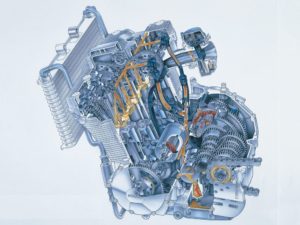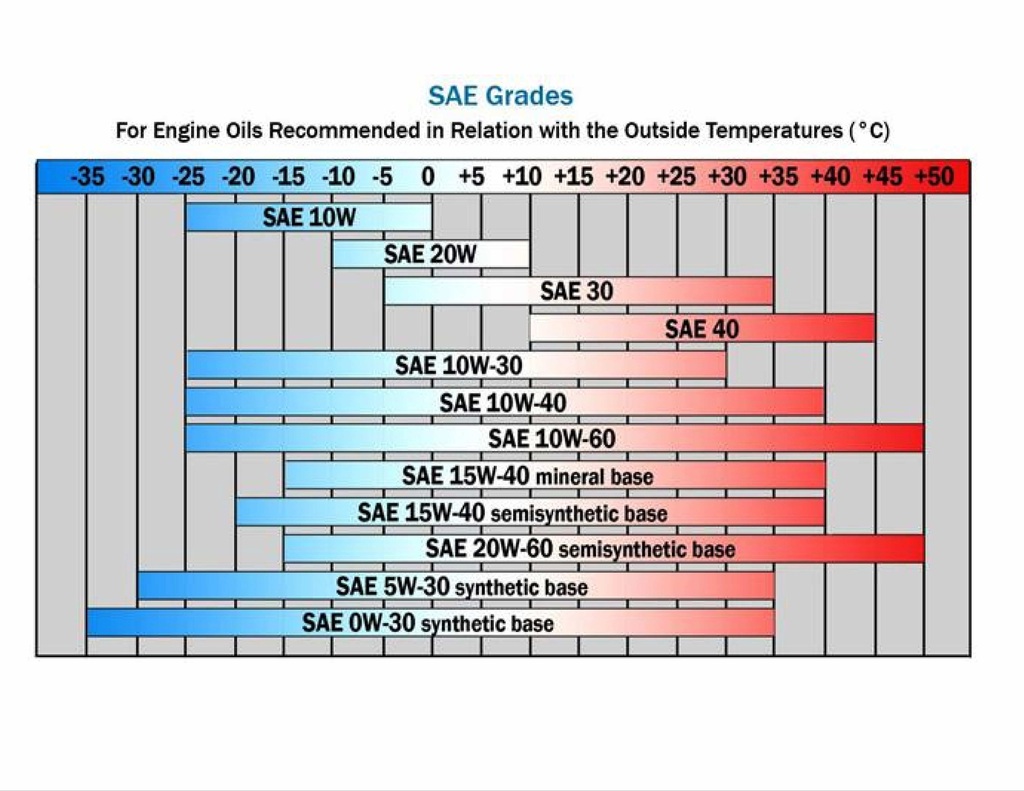Superbike-Coach Motorcycle Engine Oil Guide
Engine oil is your motorcycle’s most essential fluid – one it could not run without. It plays multiple roles in the motorcycle engine, including lubrication, cooling, sealing, cleaning, corrosion protection, and noise reduction. However, choosing the right motorcycle engine oil can be challenging. It depends on multiple factors, including your riding style and the engine’s operating conditions. Based on your frequently asked questions, we have compiled this ultimate guide to help you understand the types of motorcycle engine oil and choose the right one for your bike.
For starters, let’s explore how motorcycle lubrication works. Namely, there are three types of lubrication.
FULL FILM LUBRICATION
Full film lubrication is also called hydrodynamic lubrication. In this type of lubrication, a thick coat is created, fully separating two metal surfaces. Oil sticks to moving engine parts and is further pulled in the area between two sliding surfaces. It usually appears between the crank journal and rod bearings, as well as between the piston skirt and the cylinder wall.
Full film lubrication depends on oil viscosity. For example, if oil is too thin, it will be wrung out from between the surfaces. On the other hand, if it is too thick, the engine parts will move too slowly and the oil levels will decrease faster.
BOUNDARY LUBRICATION
This kind of lubrication takes place when the oil pump stops turning or rotates too slowly. It often happens under high-load and low engine speeds. Anti-wear additives develop a very thin protective film on metal surfaces, such as main bearings, gears, piston rings, pumps, and transmissions. The lube protects these parts from friction until hydrodynamic lubrication is created.
MIXED LUBRICATION
Mixed lubrication is, as its mere name suggests, the combination of full film and boundary lubrication. It takes place at low engine speeds when oil pressure decreases.
TYPES OF MOTORCYCLE ENGINE OIL
All engine oils consist of base oils and performance-enhancing additives. Depending on the type of base oil, motor oils are classified into three types – synthetic, semi-synthetic, and mineral.
MINERAL-BASED MOTORCYCLE OILS
Mineral oils are derived from crude petroleum. During the refining process, unwanted contaminants are eliminated. One of the greatest benefits of mineral-based oil is its low price, compared to its synthetic counterparts.
However, they do not perform as effectively as synthetic oils. They flow through the engine slower, which results in increased fuel consumption and affects the overall performance of the engine.
Also, their structure prevents the molecules from interacting in extreme operating conditions. That is why they are ideal for motorcycles with older engines or those with smaller engine capacities. Additionally, mineral oils need to be changed more frequently than synthetic oils.
SEMI-SYNTHETIC OIL
If you are looking for motorcycle engine oils that perform better in low temperatures and can block oxidation but do not want to purchase full-synthetic oils, then semi-synthetic engine oils are for you.
As their name suggests, semi-synthetic oils are a combination of mineral and synthetic oils. They are also called part-synthetic oils or synthetic blend oils. They provide better protection than conventional mineral oils, and yet, they are more affordable than fully synthetic oils.
Semi-synthetic motorcycle engine oils also contain strong synthetic additives that enhance their performance and even add some new features to the oil.
SYNTHETIC-BASED ENGINE OILS
The main difference between synthetic and mineral oils lies in their formula. Synthetic oils go through more sophisticated modifications in the lab.
Synthetic oils are most commonly used for newer motorcycle models. Any motorcycle with a larger engine capacity (higher than 200cc) should use synthetic oils. These advanced oils work far better than mineral and semi-synthetic oils. They offer exceptional lubrication and protection for engines put under larger loads of stress.

Photo courtesy of Suzuki Motor Corporation
Some of the key features that set synthetic oils apart from their mineral-based counterparts are:
- Corrosion protection
- Anti-friction
- Enhanced cooling
- Extended drain intervals
- Fewer emissions
- Improved fuel economy
Most importantly, synthetic oils last longer and provide the engine with better protection. Their major disadvantage is the high price. However, consider it a long-term investment into your two-wheeler’s high-performance.
2-STROKE AND 4-STROKE ENGINE OILS
Motorcycle and scooter engines can be four-stroke (4T) and two-stroke (2T). The core difference between them is in the number of strokes the piston moves up and down during each cycle.
TWO-STROKE MOTORCYCLE OIL
In 2-stroke engines, power is produced every two strokes of the piston. They are more cost-effective and lighter than their four-stroke counterparts.
However, they have numerous disadvantages, including fuel inefficiency, greater noise, vibrations, and high environmental impact. That is why they are often used in small engines, including mopeds, bikes, and go-carts.
Two-stroke motorcycle engines require the use of 2T engine oils. The base oil in 2T oils can be castor, petroleum, semi-synthetic, or synthetic. Modern two-stroke engines use synthetic oils that provide better protection and reduce emissions.
Advanced 2T oils also contain innovative additives that enhance the performance of base oils and even add some new features to them. Some of them are fuel stabilizers, detergents, anti-wear agents, biodegradability components, etc.
FOUR-STROKE MOTORCYCLE OIL
In a four-stroke engine, power is produced every four strokes of the piston. Each event in four-stroke engines (intake, compression, power, and exhaust) takes a separate piston movement. Precisely because of that, four-stroke engines are more fuel-efficient and produce fewer emissions than two-stroke engines.
That is why they are used in modern motorcycle engines. For a motorcycle with a four-stroke engine, you need to choose quality four-stroke oil. Unlike two-stroke lubes, four-stroke engine oils do not burn with the motorcycle fuel. Instead, they circulate and lubricate engine components. They also reduce heat and filter out impurities.
Four-stroke engine oils also have a higher concentration of performance-boosting additives, such as detergents, dispersant’s, anti-wear substances, foam retardants, etc.
When choosing four-stroke engine oils for your motorcycle, it is essential to pick ones consisting of high-quality base oils and advanced performance-boosting additives.
MOTORCYCLE VISCOSITY GRADING
Viscosity is the motor oil’s ability to resist motion or flow. In other words, it represents oil thickness. Fluids with a high viscosity develop a thicker film between engine parts, withstand pressure, and bear more pressure than low-viscosity lubricants. On the other hand, too thick oils may cause power-robbing friction.
Oil should be thick enough to develop a strong protective coating, yet not so thick to cause friction between engine parts. Namely, if the oil film completely separates two metal surfaces, it bears all of the load and causes hydrodynamic and hydro static friction. While there is no wear between your engine’s metal components, you will lose more power.
Viscosity refers to the oil’s thickness—the higher the rating, say 50 weight, the heavier or more viscous the oil is. Viscosity is a critical factor in how well the oil flows and how much protection it offers. Modern multi-viscosity oils are kind of magical. They provide the right flow characteristics and lubrication across a wide range of temperatures.
The “W” following the first number in 15W-50 stands for winter, not weight, and is a measure of the fluid’s flow rate at a seriously low temperature of -15 to -20 degrees Fahrenheit. So at sub-zero temps, 15W-50 will flow no slower than a 15-weight oil. This cold-weather behavior is critical to cranking speed and how readily the oil will flow during initial start-up in cold climates, though obviously it’s more relevant to automobile drivers than to motorcyclists. The second number in 15W-50 represents the oil’s high-temperature viscosity, as measured at a temperature of 212 degrees Fahrenheit. For 15W-50, that means the oil will be no thinner than a 50-weight oil at operating temperature.
More viscous oil provides a thicker film and better protects parts during normal operation. Your motorcycle’s manufacturer knows what viscosity range will meet the motor’s needs, so it’s important to abide by its recommendation.
CHANGE MOTORCYCLE ENGINE OIL REGULARLY
As a rule of thumb, motorcycle engine oil should be replaced every 3,000 km to 5,000 km. However, that depends on various factors, including the engine type, the manufacturer, the oil type, and your riding style.
For example, if you use your motorcycle every day or travel great distances daily, you will have to change the motor oil more frequently. Precisely because of that, it is essential to change the motorcycle engine oil at the intervals recommended by the manufacturer. Most importantly, make sure you check your engine oil to ensure it is in good condition.
Here are a few signs that your motorcycle engine oil should be changed fast:
- The oil that is dark in color: Fresh engine oil is usually trans-lucid and is blue or brown. The repeated exposure to engine combustion changes its color and consistency.
- The engine is overheating. Degraded oil has poorer thermal performance, which results in uneven distribution of heat within the engine.
- Your motorcycle engine is louder than usual. When lubricated properly, your bike’s engine produces sounds that are pleasing to the ear. Inadequate lubrication causes you to hear a harsh sound, which often results from the continuous contact of two metal surfaces.
- Your dashboard warning lights are on. Their primary task is to warn you when you do not have enough oil in the engine.
CAN I USE PASSENGER CAR OIL FOR MY TWO-WHEELER?
Car engine oil and motorcycle engine oil are not interchangeable. Therefore, it is always a better choice to use specialty motorcycle oil than car engine oils. There are a few key differences between these two types of lubricants.
The first one is the transmission. Namely, motorcycles use engine oil to cool the transmission. In passenger cars, this role is performed by transmission and ATF oils. Car oils usually consist of friction modifiers to boost engine performance, while motorcycle oils do not. When used in motorcycle transmissions, these substances may clog the system. Second, car engine oils contain far more detergent additives than motorcycle oils. If used in motorcycle engines, they might cause the accumulation of deposits and harm their components. Finally, bike engines rev more than car engines, meaning they require engine oil to have improved heat and anti-wear protection.
These types of engines are also different from the mechanical point of view. Motorcycle engines contain clutches and higher-load gearboxes that require better cooling capacities and shear stability to work properly.
CHOOSE HIGH-QUALITY OIL FOR YOUR BIKE
From the recommendations provided above, you can conclude that there is no uniform engine lubrication solution for your motorcycle. Your choice depends on various factors, such as your riding style, climate, engine type, etc.
That is why you should always follow the manufacturer’s oil recommendations. They have performed thorough analyses and know exactly what kind of lubes your motorcycle engine likes. Second, make sure you choose the recommended weight and viscosity of the oil.
 So, we hope that this comprehensive guide will help you in the long run. Get busy with it and find a solid base to go from. It’s fun to start working on your bike your own. Oil changes are a great way to start it all out. We’d love to see you in one of our 100% unique programs.
So, we hope that this comprehensive guide will help you in the long run. Get busy with it and find a solid base to go from. It’s fun to start working on your bike your own. Oil changes are a great way to start it all out. We’d love to see you in one of our 100% unique programs.
Superbike-Coach Corp




 So, we hope that this comprehensive guide will help you in the long run. Get busy with it and find a solid base to go from. It’s fun to start working on your bike your own. Oil changes are a great way to start it all out. We’d love to see you in one of our 100% unique programs.
So, we hope that this comprehensive guide will help you in the long run. Get busy with it and find a solid base to go from. It’s fun to start working on your bike your own. Oil changes are a great way to start it all out. We’d love to see you in one of our 100% unique programs.





